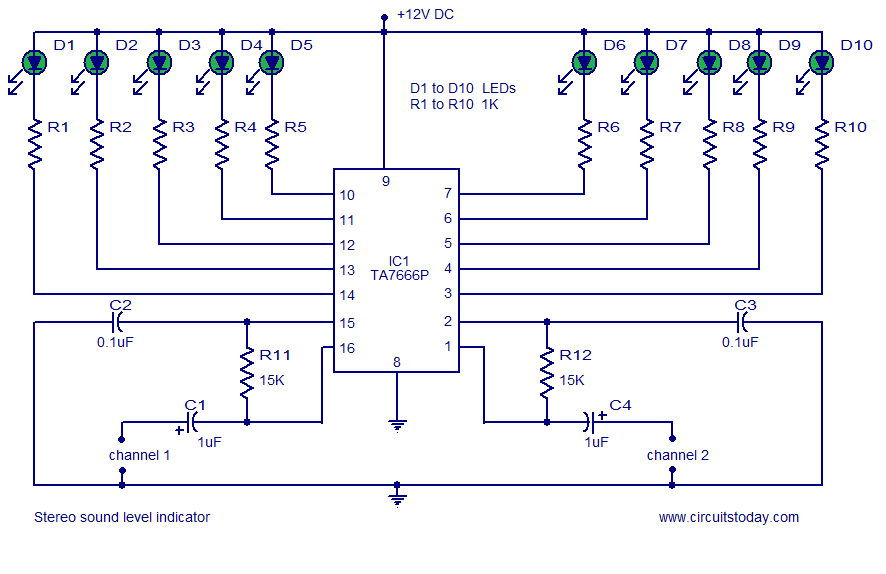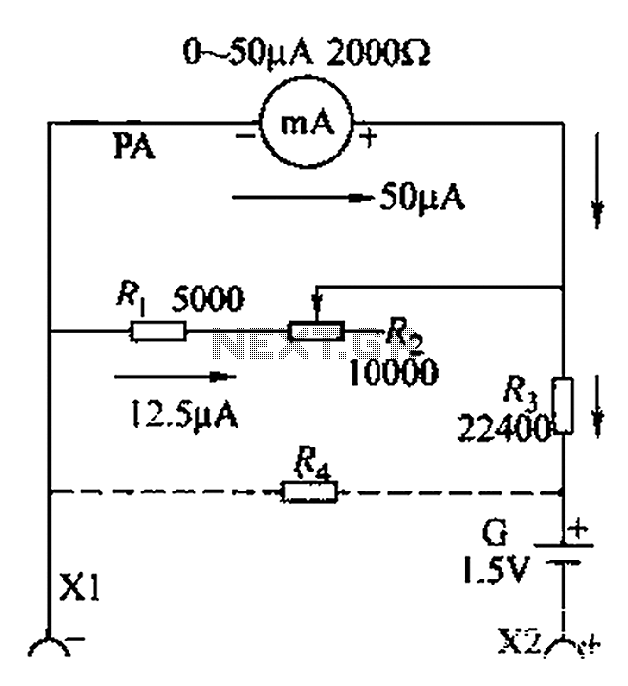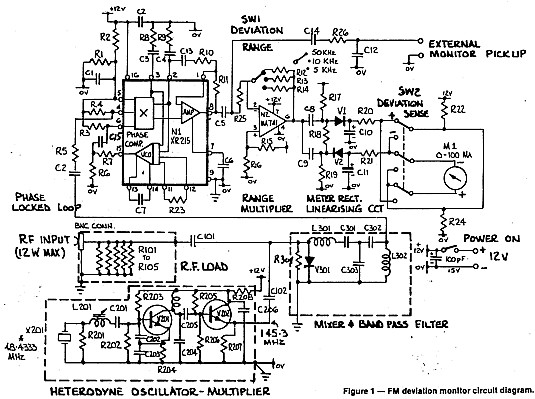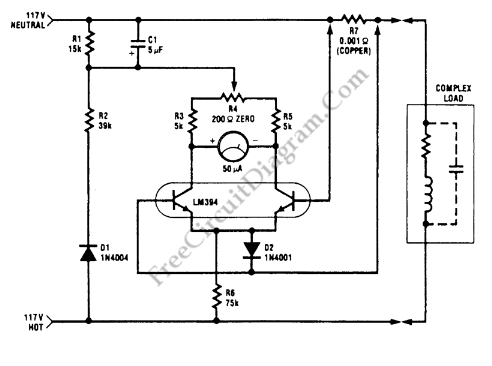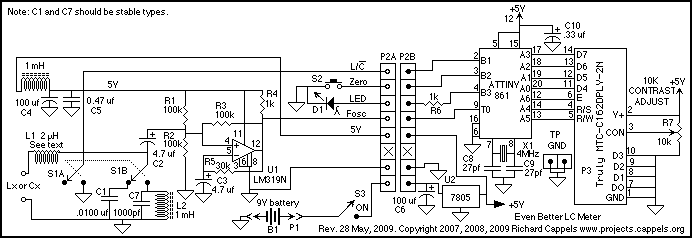
80 METER CW TRANSCEIVER WITH DIRECT CONVERSION
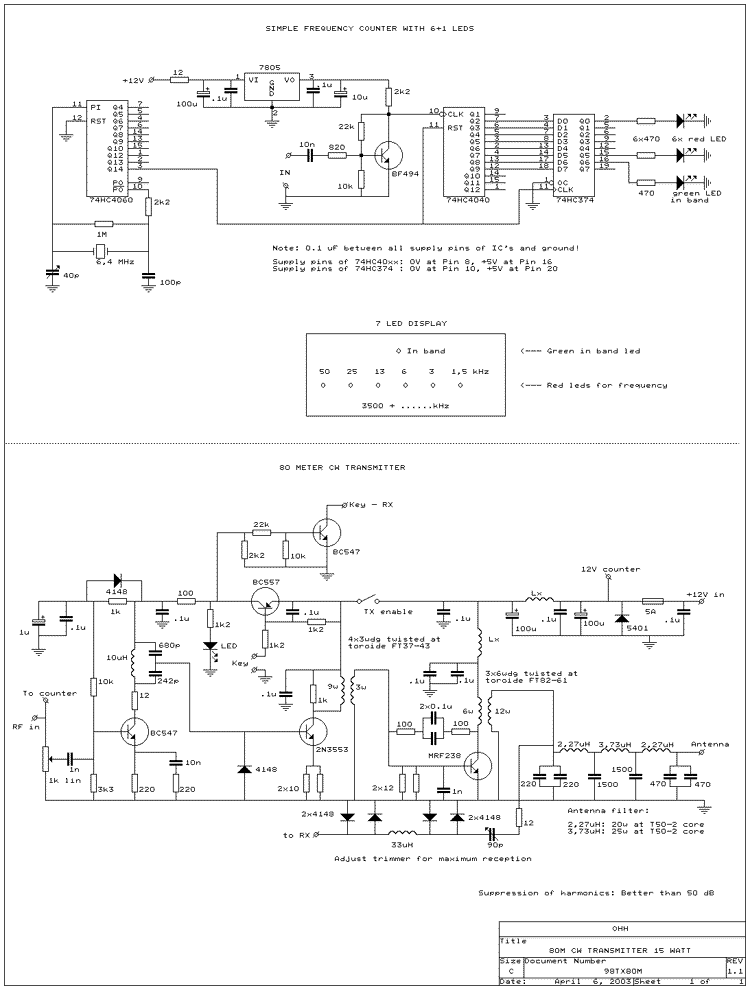
The RF signal is divided into two signals that are shifted 90 degrees out of phase (one at plus 45 degrees and one at minus 45 degrees). Both signals are then mixed to audio frequencies. The two audio signals are again shifted 90 degrees out of phase (one at plus 45 degrees and one at minus 45 degrees). When the two signals are combined, one sideband is in phase and added, while the other sideband is 180 degrees out of phase and subtracted. The RF phase shift circuits utilize simple RC combinations, with trimmers adjusted for maximum suppression at 3550 kHz. A limitation of this simple phase shift network is that sideband suppression is somewhat frequency dependent. Both mixers consist of a CMOS switch. A single 74HC4066 IC contains four CMOS switches, although only two are utilized in this application, providing a cost-effective solution for the mixer. An RF attenuator serves as the primary volume control at the input. The preselector is a bandpass filter tuned to 3550 kHz. The RF preamplifier provides gain, has a high input impedance for the bandpass filter, and a low output impedance for the phase shift networks. Following the preamplifier, the RF phase shift filters are implemented using simple RC networks, both tuned with trimmers for approximately 45 degrees of phase shift. These networks also compensate for amplitude discrepancies. For optimal phase and amplitude settings, it is possible for one network to be at plus 55 degrees and the other at minus 35 degrees, provided the difference remains 90 degrees. Adjustments can be made audibly by experimenting with trimmer settings while listening to a signal on the suppressed sideband at 3550 kHz. Typically, phase shifting occurs in the VFO rather than in the RF signal path, where the VFO operates at four times the reception frequency, utilizing dividers to achieve the 90-degree phase shift. The advantage of applying phase shifts in the RF domain, as opposed to the VFO circuit, is that the VFO can operate at a lower frequency while the RF phase shift network can correct amplitude inaccuracies. The plus and minus 45-degree phase-shifted signals are mixed to low-frequency (LF) signals using two mixers, which are also CMOS switches from the 74HC4066 series, known for their affordability and satisfactory performance. A 5k potentiometer is used to adjust the audio detection of strong broadcast stations. To achieve sideband suppression, phase shift networks are also required in the LF section, with shifts of 45 degrees across the entire LF spectrum of interest. The networks in this receiver operate with acceptable accuracy from 150 Hz to 5 kHz, although for this CW transceiver, only frequencies between 400 and 1000 Hz are significant. Components with a 5 percent accuracy rating have yielded good results. The phase shift networks comprise two operational amplifiers and several resistors and capacitors, as opposed to more complex polyphase networks. The outputs from the LF phase shift networks are combined through 5.6k ohm resistors, where the summation and subtraction of the desired and undesired sidebands occurs. The wanted sideband components are in phase at this junction and are added, while the unwanted sidebands are 180 degrees out of phase and subtracted. The audio CW filter features two bandwidths: a wide filter for comfortable listening over extended periods and a narrow filter that is effective in the presence of interference or for digital modes such as Feld Hell. LF volume control is implemented via a switch due to space constraints preventing the use of a potentiometer. This switch reduces the gain of the subsequent LM358 LF amplifier, thereby decreasing both the audio signal and the noise from the LF amplifier. Diodes limit the peaks of the LF signal to 0.7 volts to prevent overloading of the BF256A mute switch, with the =A= type recommended for its lower cutoff voltage. After the junction of the 5.6k ohm resistors at the output of the LF phase shift filters, the signal processing continues.
The described circuit effectively demonstrates a coherent approach to signal processing in RF applications, particularly in the context of a CW transceiver. The use of simple RC networks for phase shifting, combined with CMOS switch mixers, illustrates a balance between performance and cost-effectiveness. The RF preamplifier's design ensures compatibility with the bandpass filter, maintaining signal integrity while optimizing gain. The careful tuning of phase shift networks allows for precise control over sideband suppression, which is crucial for achieving clear audio output in communication applications. The implementation of dual bandwidth audio filters enhances user experience by providing flexibility in filtering options, catering to varying operational conditions. Additionally, the integration of volume control through a switch rather than a potentiometer reflects practical design considerations, ensuring noise reduction alongside audio signal management. Overall, this circuit exemplifies efficient design principles in RF and audio signal processing, suitable for various applications in amateur radio and communication systems.The RF signal is split into two signals that are shifted 90 degrees out of phase (one plus 45 and one minus 45 degrees). Both are mixed to audio frequencies. The two audio signals are again shifted 90 degrees out of phase (again one plus 45 and one minus 45 degrees).
When we add the two signals, one side band is in phase and added, the signals fro m the other side band are 180 degrees out of phase and substracted. The RF phase shift circuits are simple RC combinations, the trimmers are adjusted for maximum suppression at 3550 kHz. The disadvantage of such a simple phase shift network is that the side band suppression is a little frequency dependent.
Both mixers are a CMOS switch. One 74HC4066 IC contains even four CMOS switches of which only two are used here! So a very simple and cheap solution for the mixer! At the input, you will find the very useful RF attenuator. It is the main volume control. The preselector is a bandfilter tuned to 3550 kHz. The RF preamplifier has some gain, a high input impedance for the bandfilter and a low output impedance for the phase shift networks. After this preamplifier we have the RF phase shift filters. It are simple RC networks, both tuned with the trimmers for approximately 45 degrees phase shift. They also compensate for amplitude differences. For optimum settings for phase and amplitude, it is possible that one network is plus 55 degrees, the other minus 35 degrees as long as the difference is 90 degrees.
Adjust it by ear, try different trimmer settings while adjusting the other at 3550 kHz while listening to a signal on the suppressed side band. Usually, phase shifting is not done in the RF signal path but in the VFO. In that case, the VFO works at 4 times the reception frequency. The 90 degrees phase shift is obtained by dividers. The advantage of phase shift in the RF part instead of in the VFO circuit is that the VFO can work at the 4 times lower reception frequency and the RF phase shift network can also be used to correct for amplitude inaccuracies.
The plus and minus 45 degrees phase shifted signals are mixed to LF frequencies by two mixers. These mixers are CMOS switches of a 74HC4066, very cheap and performance is good. Adjust the 5k potentiometer for minimum audio detection of strong broadcast stations. To obtain the side band suppression, we also need phase shift networks in the LF part. The shifts have to be 45 degrees over the whole LF spectrum we want to receive. The networks in this receiver do their work with acceptable accuracy from 150 Hz to 5 kHz. However, for this CW transceiver only frequencies between 400 and 1000 Hz are important. I did use components with an accuracy of 5 percent with good results. The phase shift networks are a circuit with two op-amps and a few resistors and capacitors instead of the better but more complex polyphase networks. Both signals from the LF phase shift networks are added via 5k6 ohm resistors. Here the summation and substraction of the wanted and unwanted side bands happens. The wanted side band components are in phase on this point and are added, the unwanted side band are 180 degrees out of phase and substracted.
The audio CW filter has to bandwidths, a wide filter and a narrow filter. The wide filter is more pleasant and less tiring when listening for long periods, the narrow filter is very good when there is interference or for digital mode`s like Feld Hell. LF volume control is done by a switch as there was no place for a potentiometer. The switch lowers the gain of the next LM358 LF amplifier. The advantage is that not only the audio signal is decreased but also the noise of the LF amplifier. The diodes are limiting the peaks of the LF signal to 0. 7 volt to prevent overloading of the BF256A mute switch. Take an =A= type for the BF256 as it has the lowest cut off voltage. 2. After the junction of the 5k6 ohm resistors at the output of the LF phase shift filters, the 🔗 External reference
The described circuit effectively demonstrates a coherent approach to signal processing in RF applications, particularly in the context of a CW transceiver. The use of simple RC networks for phase shifting, combined with CMOS switch mixers, illustrates a balance between performance and cost-effectiveness. The RF preamplifier's design ensures compatibility with the bandpass filter, maintaining signal integrity while optimizing gain. The careful tuning of phase shift networks allows for precise control over sideband suppression, which is crucial for achieving clear audio output in communication applications. The implementation of dual bandwidth audio filters enhances user experience by providing flexibility in filtering options, catering to varying operational conditions. Additionally, the integration of volume control through a switch rather than a potentiometer reflects practical design considerations, ensuring noise reduction alongside audio signal management. Overall, this circuit exemplifies efficient design principles in RF and audio signal processing, suitable for various applications in amateur radio and communication systems.The RF signal is split into two signals that are shifted 90 degrees out of phase (one plus 45 and one minus 45 degrees). Both are mixed to audio frequencies. The two audio signals are again shifted 90 degrees out of phase (again one plus 45 and one minus 45 degrees).
When we add the two signals, one side band is in phase and added, the signals fro m the other side band are 180 degrees out of phase and substracted. The RF phase shift circuits are simple RC combinations, the trimmers are adjusted for maximum suppression at 3550 kHz. The disadvantage of such a simple phase shift network is that the side band suppression is a little frequency dependent.
Both mixers are a CMOS switch. One 74HC4066 IC contains even four CMOS switches of which only two are used here! So a very simple and cheap solution for the mixer! At the input, you will find the very useful RF attenuator. It is the main volume control. The preselector is a bandfilter tuned to 3550 kHz. The RF preamplifier has some gain, a high input impedance for the bandfilter and a low output impedance for the phase shift networks. After this preamplifier we have the RF phase shift filters. It are simple RC networks, both tuned with the trimmers for approximately 45 degrees phase shift. They also compensate for amplitude differences. For optimum settings for phase and amplitude, it is possible that one network is plus 55 degrees, the other minus 35 degrees as long as the difference is 90 degrees.
Adjust it by ear, try different trimmer settings while adjusting the other at 3550 kHz while listening to a signal on the suppressed side band. Usually, phase shifting is not done in the RF signal path but in the VFO. In that case, the VFO works at 4 times the reception frequency. The 90 degrees phase shift is obtained by dividers. The advantage of phase shift in the RF part instead of in the VFO circuit is that the VFO can work at the 4 times lower reception frequency and the RF phase shift network can also be used to correct for amplitude inaccuracies.
The plus and minus 45 degrees phase shifted signals are mixed to LF frequencies by two mixers. These mixers are CMOS switches of a 74HC4066, very cheap and performance is good. Adjust the 5k potentiometer for minimum audio detection of strong broadcast stations. To obtain the side band suppression, we also need phase shift networks in the LF part. The shifts have to be 45 degrees over the whole LF spectrum we want to receive. The networks in this receiver do their work with acceptable accuracy from 150 Hz to 5 kHz. However, for this CW transceiver only frequencies between 400 and 1000 Hz are important. I did use components with an accuracy of 5 percent with good results. The phase shift networks are a circuit with two op-amps and a few resistors and capacitors instead of the better but more complex polyphase networks. Both signals from the LF phase shift networks are added via 5k6 ohm resistors. Here the summation and substraction of the wanted and unwanted side bands happens. The wanted side band components are in phase on this point and are added, the unwanted side band are 180 degrees out of phase and substracted.
The audio CW filter has to bandwidths, a wide filter and a narrow filter. The wide filter is more pleasant and less tiring when listening for long periods, the narrow filter is very good when there is interference or for digital mode`s like Feld Hell. LF volume control is done by a switch as there was no place for a potentiometer. The switch lowers the gain of the next LM358 LF amplifier. The advantage is that not only the audio signal is decreased but also the noise of the LF amplifier. The diodes are limiting the peaks of the LF signal to 0. 7 volt to prevent overloading of the BF256A mute switch. Take an =A= type for the BF256 as it has the lowest cut off voltage. 2. After the junction of the 5k6 ohm resistors at the output of the LF phase shift filters, the 🔗 External reference
